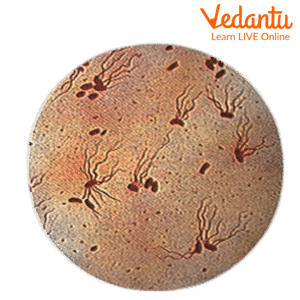




How to Identify and Manage Typhoid Symptoms in Children
You all might have suffered from a fever. There are many reasons for fever. One of them is Typhoid. Typhoid is an infectious bacterial disease that mainly spreads through contaminated food or water. It can also spread due to poor hygienic conditions. Salmonella typhi is the bacterium responsible for this disease and humans are the only carriers. In the early 1900s, the United States reported its first case of typhoid fever. Approximately 21 million people worldwide contract this illness each year, and 200,000 instances result in death. Now, we are going to see about typhoid in detail. We will cover the topics like typhoid symptoms in kids, why typhoid attacks, and causes of typhoid.

A patient with Typhoid
What Causes Typhoid Fever?
The bacterium Salmonella typhi is what causes typhoid fever. By consuming food or drinking water that has been tainted by a patient or carrier of the sickness, the bacteria can be spread from one person to another. The infected person's stool contains the bacterium.
There is a famous story about typhoid. This story is of a lady named Mary Mallon. Mary Mallon, often known as Typhoid Mary, was an American chef of Irish descent who is thought to have exposed 51 to 122 persons to typhoid illness. With estimations of up to 50 for unconfirmed mortality, the illnesses resulted in three verified fatalities.
Causes of Typhoid
By consuming or drinking infected food or water, one can get typhoid fever. Stool from sick people, which has a high concentration of bacteria, can contaminate the local water supply and can become a reason for typhoid. Food supply contamination due to water supply contamination is possible. The bacteria can stay and grow in water or dried sewage for weeks.
After the severe sickness, between 3 and 5% of persons develop germs as carriers. Others go undiagnosed because they have a relatively little ailment. Even though they show no symptoms, these individuals may become long-term carriers of the germs and, for many years, serve as the source of fresh typhoid fever outbreaks.

Salmonella Typhi
Symptoms of Typhoid
The illness lasts for 3–4 weeks and often has an incubation period of 1–2 weeks. These signs include the following:
Lack of appetite
Headaches
Various aches and pains throughout
Fever of 104 degrees Fahrenheit or higher
Lethargy
Diarrhoea

Symptoms of Typhoid
Many patients have chest congestion as well as frequent stomach pain and discomfort. As the fever persists, in people with no issues, improvement happens in the third and fourth week. After feeling better for one to two weeks, 10% of patients experience recurrence symptoms. Relapses are more frequent in people using antibiotics.
Treatment for Typhoid in India
Antibiotics are used to treat typhoid fever because they eliminate the Salmonella germs. 20 percent of patients died before antibiotics were used. Intestinal bleeding, pneumonia, overpowering infection, or intestinal perforation all resulted in death. Mortality has been cut in half to between 1 and 2 per cent with the use of supportive treatment and antibiotics. With the proper antibiotic therapy, healing often occurs in seven to ten days after improvement occurs within one to two days.
Typhoid fever can be effectively treated with several drugs. For many years, chloramphenicol was the first medication of choice. Other powerful antibiotics have taken the role of chloramphenicol due to its uncommonly severe adverse effects.
By determining the location of the infection, the selection of antibiotics is influenced (certain strains from South America show significant resistance to some antibiotics). Patients receive antibiotic treatment once again if relapses take place. It will show signs of recovery from typhoid.
Prolonged antibiotic therapy is an option for those who develop chronic illness (about 3 percent to 5 percent of infected people). Frequently, the gallbladder must be removed because it is the source of the chronic infection. Vaccines are now accessible for people travelling to high-risk areas.
Summary
Typhoid is an infectious disease. It spreads through contaminated food and water. Fever is the most common symptom of typhoid. In this article, we discussed typhoid fever, why typhoid attacks, and what are the causes and reasons for typhoid fever. Symptoms of Typhoid were discussed in depth along with the treatment provided, particularly in India. It is an infection that spreads through contaminated food and water. The treatment of Typhoid available in India is also discussed in depth in this article. Typhoid can be treated with the help of antibiotics. I hope this article will clear all your doubts regarding typhoid. If you have any questions, please feel free to ask in the comment section.
FAQs on Typhoid Symptoms in Kids: Early Signs, Causes & Recovery
1. What are the main symptoms of typhoid in kids?
The primary symptom of typhoid in children is a high fever that gradually increases over several days. Other common signs include:
Extreme fatigue and weakness
Headache and body aches
Stomach pain
Loss of appetite
Constipation or, in some cases, diarrhoea
A rash of flat, rose-coloured spots on the chest or abdomen
You can learn about the symptoms of various diseases for a broader understanding.
2. What are the clear signs that a child is recovering from typhoid?
Signs of recovery from typhoid become apparent after starting a course of antibiotics. The key indicators include the fever breaking and the child's body temperature returning to normal. You will also notice a significant return of appetite, a gradual increase in energy levels, and a reduction in stomach discomfort and headaches. It is crucial to complete the full antibiotic course even after symptoms subside to ensure all bacteria are eliminated.
3. How long does it typically take for a child to recover from typhoid?
With prompt and appropriate antibiotic treatment, a child's fever usually begins to improve within 2 to 3 days. A full recovery from the main symptoms typically takes about 7 to 10 days. However, the feeling of weakness and fatigue can persist for a few more weeks. Typhoid is an acute illness, which means it develops suddenly but can be cured completely with proper medical care.
4. How is typhoid fever diagnosed in children?
A doctor will first assess the child's symptoms and perform a physical exam. To confirm the diagnosis, specific lab tests are required. The most reliable method is a blood culture, which checks for the presence of the Salmonella typhi bacteria. Other diagnostic tests include analysing stool and urine samples and blood tests like the Widal test to detect antibodies against the bacteria, which usually become positive in the second week of the illness.
5. What does the typical treatment for typhoid in children involve?
The standard treatment for typhoid in children is a prescribed course of antibiotics to kill the Salmonella typhi bacteria. It is essential to complete the entire course as directed by the doctor. Alongside medication, treatment involves supportive care, including ensuring the child gets plenty of rest, stays hydrated with clean water and fluids, and eats a nutritious, easily digestible diet to support their recovery.
6. How can a parent help a child recover from the weakness after typhoid?
Post-typhoid weakness, or asthenia, is very common. To help your child regain strength, focus on two key areas: nutrition and rest. Provide a balanced diet rich in proteins and calories through small, frequent meals. Ensure they get adequate sleep and gradually reintroduce physical activities, avoiding anything too strenuous for a few weeks. Proper hydration with water, soups, and juices also plays a vital role in overcoming fatigue.
7. What kind of diet is recommended for a child's fast recovery from typhoid?
During and after typhoid, a child's digestive system is weak, so an easily digestible yet high-energy diet is crucial. Recommended foods include:
High-Calorie Foods: Boiled rice, porridge (dalia), boiled potatoes, and bananas.
Easy-to-Digest Proteins: Yoghurt (curd), lentil soup (moong dal), and boiled eggs.
Fluids for Hydration: Coconut water, clear vegetable soups, fruit juices, and Oral Rehydration Solution (ORS).
It is important to avoid spicy, oily, and high-fibre foods like raw salads until recovery is complete.
8. Why is typhoid more common in children during the monsoon season?
The monsoon season often leads to an increase in waterborne diseases like typhoid. This is because heavy rainfall can cause sewage to mix with drinking water sources, contaminating them with the Salmonella typhi bacterium. Children are more vulnerable as their immune systems are still developing and they might consume contaminated water or street food without realising the risk. This makes practicing strict food and water hygiene especially important during this season.
9. What are the different stages of typhoid in children, and what are the risks if it's left untreated?
If left untreated, typhoid typically progresses through four stages over four weeks. In the first week, there is a slowly rising fever. By the second week, the fever is high, and stomach pain develops. By the third week, serious complications can arise. The biggest risk of untreated typhoid is intestinal perforation (a hole developing in the intestine) or haemorrhage, which are medical emergencies. Prompt diagnosis and treatment are vital to prevent these severe outcomes related to this aspect of human health and disease.
10. Can a child get typhoid more than once?
Yes, it is possible for a child to get typhoid more than once. Having the disease does not guarantee lifelong immunity. A person can be reinfected if they consume contaminated food or water again. Additionally, a small number of people can become asymptomatic carriers after recovering. They harbour the bacteria and can pass it to others without showing any symptoms themselves, which is why vaccination and public sanitation are so important.









